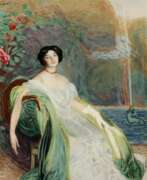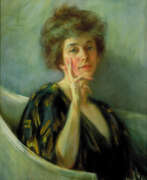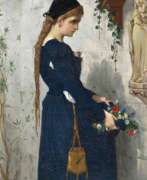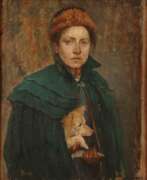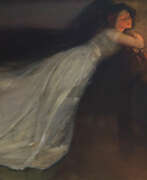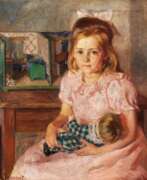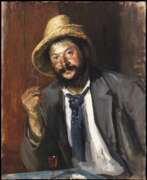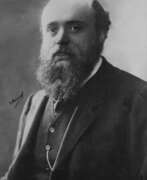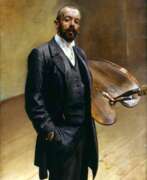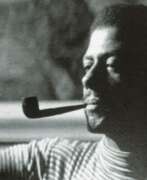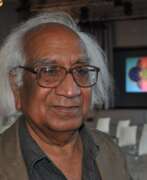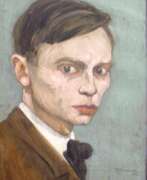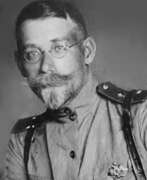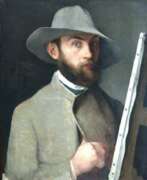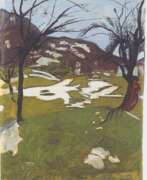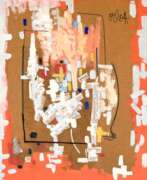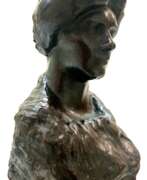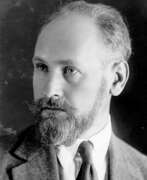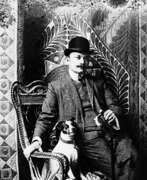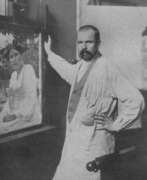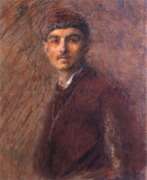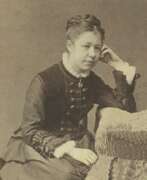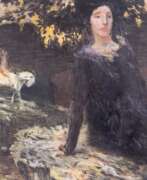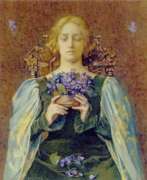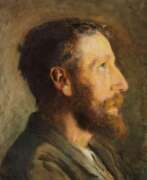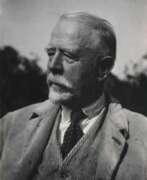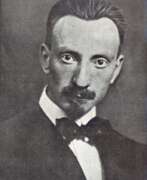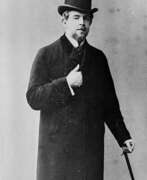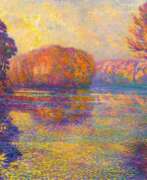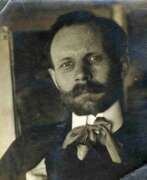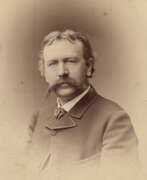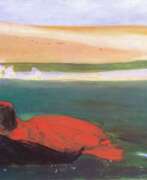Portraitist Symbolism
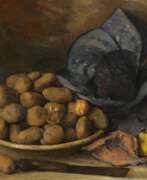

Wilhelm Schmurr was a German painter and co-founder of the Sonderbund in Düsseldorf. His style, characterized by clear expression, was influenced by the Pre-Raphaelites, Symbolists, and Realists. He received several awards and medals for his work and was a member of various art associations. Schmurr taught at the Kunstakademie Düsseldorf and inspired by the farmers after the war, he created scenes of simple life and still lifes. He was awarded the Karl-Ernst-Osthaus-Preis and the Bundesverdienstkreuz erster Klasse and became an honorary member of various artist associations.
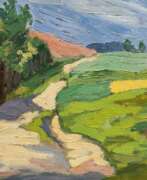

Louise Elisabeth Andrae was a German Post-Impressionist landscape painter and watercolorist. She studied with two landscape painters; Gustav Adolf Thamm in Dresden and Hans von Volkmann in Karlsruhe. She settled in Dresden, but spent long periods on the island of Hiddensee. There, she helped organize a group known as the Hiddensoer Künstlerinnenbund, an association of women artists that included Clara Arnheim, Elisabeth Büchsel, Käthe Loewenthal and Katharina Bamberg. They were regular exhibitors at an art venue known as the Blaue Scheune (Blue Barn), established in 1920 by Henni Lehmann. She also exhibited frequently with a group known as the Kunstkaten in Ahrenshoop.Wikipedia


Boris Georgievich Birger (Russian: Борис Георгиевич Биргер) was a Soviet artist of the second half of the twentieth century of Jewish origin. He is known as a portrait painter, a representative of "unofficial art", a follower of symbolism.
Boris Birger developed his individual style of portrait painting, recognizable by his colorism. He often portrayed representatives of the liberal creative intelligentsia and was twice expelled from the Union of Artists of the USSR because of his criticism of official cultural policy.
In the 1970s his work was recognized abroad, especially in Germany, and from 1990 he lived in that country.
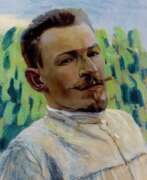

Victor Elpidiforovich Borisov-Musatov (Russian: Ви́ктор Эльпидифо́рович Бори́сов-Муса́тов) was a distinguished Russian artist celebrated for his unique contribution to the Post-Impressionist movement, combining elements of Symbolism, realism, and a decorative style that was all his own. Born in 1870 in Saratov, Russia, into the family of a former serf, Borisov-Musatov overcame early challenges, including a spinal injury that left him humpbacked, to emerge as a pivotal figure in Russian art. His education spanned the Moscow School of Painting, Sculpture and Architecture, and the Imperial Academy of Arts in Saint-Petersburg, further enriched by studies in Paris under the tutelage of Fernand Cormon. His admiration for French contemporaries, especially Pierre Puvis de Chavannes and Berthe Morisot, profoundly influenced his artistic direction.
Borisov-Musatov is renowned for his lyrical, evocative works that often depict the serene and idyllic life of the 19th-century Russian nobility, set against the backdrop of their estates. This half-illusory world, which he masterfully created, reflects a deep nostalgia and a retreat from the industrial harshness of his time. By integrating figures seamlessly into the landscapes, as seen in masterpieces like "The Pool" (1902) and "The Phantoms" (1903), he achieved a harmony that resonates with viewers for its beauty and tranquility. His use of mixed media, including tempera, watercolor, and pastel, allowed for subtle visual effects, making his works distinctive in their soft, dreamlike quality.
Borisov-Musatov's legacy extends beyond his paintings; he was a significant figure in the Russian Symbolist movement and a founding member of the Moscow Association of Artists. His works, which provide a poignant, poetic commentary on the era he lived in, are celebrated in Russian and international art circles alike. Notable paintings like "The Pool" and "The Phantoms" not only highlight his technical skill but also his ability to evoke emotion and atmosphere, making them favorites among collectors and art enthusiasts.
For collectors and experts in art and antiques, Borisov-Musatov's oeuvre offers a fascinating glimpse into the Russian Symbolist movement and the broader cultural milieu of the late 19th and early 20th centuries. His works, preserved in museums and private collections around the world, continue to enchant and inspire.
For those interested in staying informed about new product sales and auction events related to Victor Elpidiforovich Borisov-Musatov, subscribing for updates is highly recommended. This subscription ensures that enthusiasts and collectors alike will not miss the opportunity to own a piece of this remarkable artist's legacy, encapsulating the elegance and serenity that define his work.
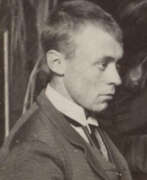

Pieter Cornelis de Moor, a Dutch artist, stands out as a versatile and innovative figure in the art world. His education at the Academy of Visual Arts in Rotterdam and the Drawing Academy in Antwerp laid the foundation for a career marked by diversity and creativity. De Moor's achievements, including a silver medal in the Prix de Rome in 1887, underline his early recognition and the promise of his artistic journey.
De Moor's artistry was not confined to a single medium; he was adept in drawing, etching, painting, watercolor, producing lithographs, and working as an illustrator. His artworks, ranging from "Dancing Women" to "Poultry on a Yard" and "An Elegant Lady Feeding Peacocks," showcase his broad thematic interests and technical skills. Notably, his works are held in prestigious collections, including the Rijksmuseum and the Dordrechts Museum.
The artist's life was rich with experiences, having worked across Europe and eventually settling in the United States. His legacy, punctuated by exhibitions in museums such as Museum Boijmans Van Beuningen and the Drents Museum, continues to captivate art enthusiasts and collectors.
For collectors and art experts, delving into the works of Pieter Cornelis de Moor offers a unique glimpse into the evolution of Dutch art. His contributions, particularly in the realm of Symbolism, highlight an era of artistic exploration and innovation.
Stay informed about new product sales and auction events related to Pieter Cornelis de Moor by signing up for updates. This subscription is your gateway to the latest acquisitions and opportunities in the world of this distinguished artist.
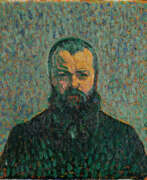

Auguste de Niederhäusern, better known as Rodo, was a Swiss sculptor and medallist. He is considered one of the most influential representatives of Swiss Symbolism.
In 1892 Rodo took part in the Salon de la Rose-Croix exhibition and for the next six years was a collaborator of Auguste Rodin.
Between 1900 and 1902, Rodot created several works for the Federal Palace in Bern, which was under construction: at the top of the pediment is a sculptural group symbolising political independence, executive and legislative power; he also created the capstones on the arched windows of the south façade.
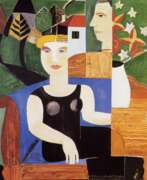

Gustave Franciscus De Smet was a Belgian painter. Together with Constant Permeke and Frits Van den Berghe, he was one of the founders of Flemish Expressionism. In 1908, he and his wife followed Léon to the artists' colony in Sint-Martens-Latem. There, they initially came under the influence of Luminism and the painter Emile Claus, who lived in nearby Astene. At the beginning of World War I, he and his family joined his friend, Van den Berghe, and fled to the Netherlands. From 1914 to 1922, they moved about, visiting and staying at the art colonies in Amsterdam, Laren and Blaricum.[2] His meeting with the Expressionist painter Henri Le Fauconnier marked a turning point in his style which, up until then, owed much to Cubism. In 1927, he settled in Deurle. It was there that his mixture of Expressionism and Cubism peaked, with a series of works depicting circus, fairground and village scenes. After his death in Deurle at the age of sixty-six, his house was preserved as a local museum.
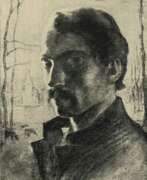

Robert Lvovich Genin (Russian: Роберт Львович Генин) was a Jewish-born artist of the first half of the twentieth century who worked in several countries, including the Russian Empire, Germany, France, Germany, Switzerland, and the USSR. He is known as a painter and graphic artist.
Robert Genin worked in a variety of genres including landscapes, portraits, genre compositions and nudes. He also did lithography, woodcuts and etching. His style evolved from Jugendstil and Symbolism in the early 1900s to Expressionism after the First World War. He later came to a kind of lyrical primitivism. The artist worked in both easel and monumental painting and was influenced by various artists.
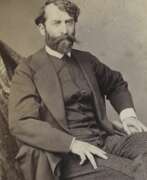

Ferdinand Heilbuth was a nineteenth-century German painter who spent much of his career in France. He is particularly known as a watercolorist, one of the first members of the Society of French Watercolorists.
Heilbuth initially became famous for his portraits done in the style of Titian and Rembrandt. Later, however, he abandoned the portrait genre entirely in favor of historical and everyday subjects and began to depict scenes from the high society of past times. Then, having become a plein air painter, he painted landscapes in Paris and made sketches in London. His paintings were distinguished by their lightness, airiness and masterful technique, and his watercolors were especially skillful.
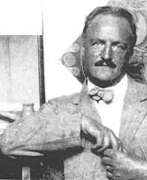

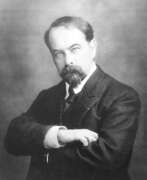

Henri Eugène Le Sidaner was a French painter known for his intimate, atmospheric landscapes and still-life paintings. He was born in Port Louis, Mauritius, but grew up in northern France and studied art at the École des Beaux-Arts in Paris.
Le Sidaner's early work was influenced by the Impressionists, but he later developed his own distinctive style characterized by a subdued palette, soft brushwork, and a focus on capturing the effects of light and atmosphere. His paintings often depict gardens, parks, and rural landscapes, as well as interiors and still-life arrangements.
Le Sidaner was also known for his use of light and shadow, which he used to create a sense of depth and mood in his paintings. He was particularly interested in the way that light and shadow interacted in interior spaces, and many of his paintings depict quiet, contemplative scenes bathed in a soft, diffuse light.
Le Sidaner's work was widely exhibited during his lifetime, and he received many awards and honors, including the Legion of Honor in France. His paintings are now included in many important collections, including the Musée d'Orsay in Paris and the Metropolitan Museum of Art in New York.


Matthias Maris was a Dutch painter, etcher and lithographer. He initially belonged to the Hague School, like his two brothers, Jacob and Willem, but his later works deviated more and more from that school into a unique style influenced by the Pre-Raphaelites. Most of the paintings by M. Maris are in museums and private collections in Great Britain and the USA. A great admirer of the artist's talent was Vincent van Gogh.
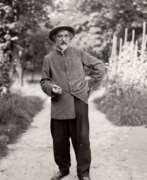

Constant Montald was a Belgian painter, muralist, sculptor, and teacher. In 1874, while receiving an education in decorative painting at the technical school of Ghent during the day, Montald also enrolled in the evening-classes of the Royal Academy of Fine Arts in Ghent. There he won in 1885 a competition and received a grant from the city which enabled him to live and study briefly in Paris at the École des Beaux-Arts. In Paris he painted his first monumental canvas, The Human Struggle. In 1886, Montald went on to win the Belgian Prix de Rome. He then went on a grand tour of Italy. He traveled extensively until he eventually settled in Florence, where he made preparations for a Grand work he eventually completed in Rome. This grand work, titled "Social Contradictions", was kept in the basement of the Royal Museum of Art and History of Brussels after it was displayed there in 1890 after being sent over from Rome. The First World War prevented Montald from painting Monumental works, instead he focused on painting on an easel. Montald co-founded the group L'art monumental. This group promoted a decorative monumental style connected to architecture.
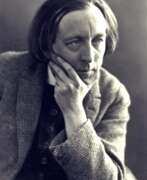

Charles-Clos Olsommer was a Swiss painter and draftsman of French descent. His favorite subjects were women's portraits and landscapes. He was a mystical and symbolic painter, and Olsommer's art echoed the Italian Early Renaissance, icon painting, and Art Nouveau aesthetics.
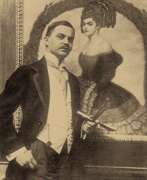

Hanns Pellar was an Austrian painter and illustrator. He studied painting at the Vienna Academy of Fine Arts under Heinrich Lefler.
Hanns Pellar was one of Munich's most prominent painters, whose quality craftsmanship and very pleasing images were characteristic of the Prince Regent's era. As a "favourite of various respected Darmstadt families", he produced a large number of portraits, especially of ladies, which eventually earned him the nickname "painter of elegance".
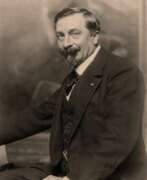

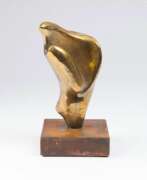

Dagmar Riese is a German painter, graphic artist and sculptor. He studied sculpture, painting and restoration at the art school in Flensburg. He was also a private pupil of the Basel artist Barbara Linhart. Dagmar Riese currently lives and works in Hamburg, Germany.
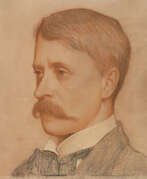

Frederick Cayley Robinson was an English artist, creating paintings and applied art including book illustrations and theatre set designs. Along with a number of other British artists, Cayley Robinson continued to paint striking Pre-Raphaelite and Victorian subjects well into the twentieth century despite this approach becoming deeply unfashionable. His work has been examined in a PhD thesis by Alice Eden and an exhibition Modern Pre-Raphaelite Visionaries at Leamington Spa Art Gallery & Museum.


Raphael Schwartz was a multifaceted Russian artist with Ukrainian origins, celebrated for his work as a painter, printmaker, and sculptor. Born on October 1, 1874, in Kiev, he later settled in Paris in 1892 after marrying a French aristocrat. His presence in the artistic hub of Paris, particularly at the Villa des Ternes, allowed him to nurture a vibrant social life, described by his friend, sculptor Jacques Loutchansky, as active and filled with humor.
Schwartz's artistic versatility is showcased in works like the 'Seated female Nude', a bronze sculpture noted for its brown patina and fine craftsmanship. This piece is signed 'Raphael Schwartz' and carries the foundry mark 'CIRE C. VALSUANI PERDUE', indicating the quality and authenticity valued by collectors and auctioneers.
Educated at Académie Julian, Schwartz's contributions to the art world were acknowledged when he was awarded the Legion of Honour. His legacy as an artist is grounded in the Russian and French traditions, despite the tragic end to his life by suicide in Pau, France, on August 3, 1942.
For those interested in the rich tapestry of art history and the works of Raphael Schwartz, signing up for updates is essential to stay informed about this distinguished artist's enduring influence.


Ludwig von Herterich was a German painter of the late nineteenth and first third of the twentieth centuries. He is known as a painter, teacher, younger brother and pupil of the famous painter Johann Herterich.
Ludwig von Herterich was mainly engaged in portrait and historical-monumental painting, he participated in the artistic design of the Wolfsbrunn Castle in the Ore Mountains. He is considered one of the brightest representatives of the Munich school of painting. He was a member of the Munich Secession and the German Artists' Association. He was awarded the Bavarian Order of Merit for Science and Arts, King Ludwig III also awarded him the Knight's Cross of the Order of Merit of the Bavarian Crown. This entitled the artist to personal nobility and he was allowed to mention his family name with the prefix "von".
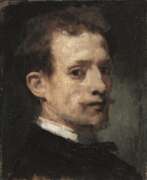

Hans von Marees was a German artist of the mid-nineteenth century. He is known as a painter and graphic artist, a representative of symbolism.
Von Marees was a prominent not only practitioner but also art theorist. He created the "Roman Circle" of German artists, whose activities in Italy seriously influenced the development of fine art of the turn. Marees 's work was centered on the theme of harmonious coexistence between man and nature, he sought to achieve the ideal relationship between form and space, as in the art of the ancient Greeks and the Italian Renaissance. At the height of his career, he turned to mythological subjects and developed a sophisticated technique, creating deep and saturated colors with layers of oil paint.
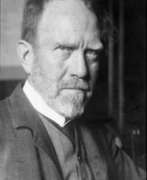

Carl von Marr was an American-born German painter of the late nineteenth and first third of the twentieth centuries. He is known as a painter and teacher, a professor at the Munich Academy of Fine Arts.
Carl von Marr worked in religious, mythological, and domestic genres, and also painted portraits. He received gold medals in Germany and the United States, where his works were exhibited. The master was a member of the board of directors of the German Artists Association.


Jean-Édouard Vuillard was a French artist, celebrated for his role in the avant-garde group Les Nabis. Known for his decorative art and printmaking, Vuillard's work was heavily influenced by Japanese prints, which is evident in his unique style of flattened color planes and simplified forms. His paintings, often of interior scenes, are distinguished by their intimate and domestic subjects, displaying a keen sensitivity to the subtle dynamics of everyday life.
In the late 1880s, Vuillard joined Les Nabis, a group of artists who sought to break away from traditional artistic concepts. This association played a pivotal role in shaping his artistic philosophy. Vuillard’s early works, like "The Seamstresses" (1890) and "Child in an Orange Shawl" (1894–95), demonstrate his evolving style, marked by the use of vibrant colors and a distinct lack of perspective, aimed at exploring spatial relationships.
Vuillard's artistic journey included ventures into theater decoration and interior design. He designed stage sets and theater programs, notably for Lugné-Poe's Theatre de l’Oeuvre, and also worked on large-scale panel paintings for French patrons. His close collaboration with the Natanson brothers, founders of the cultural review La Revue Blanche, was significant in his career. This association brought him various commissions, including decorative works for private homes and public buildings.
Vuillard's art evolved over time, transitioning from his Nabis-style works to more naturalistic portraits in the 1920s and 1930s. Despite this shift, his focus remained on portraying the intricacies of domestic life, often featuring the people closest to him. Notable among his subjects were Misia Natanson, a prominent figure in the Parisian cultural scene, and Lucy Hessel, with whom Vuillard had a long-term relationship.
For art collectors and experts, Vuillard's works are a window into the intimate spaces of Parisian life at the turn of the century. His ability to transform everyday scenes into art makes his work particularly appealing. Pieces like "The Green Interior" (1891) and "Breakfast at Villerville" (1910) are exemplary of his style and are celebrated for their quiet yet profound depiction of ordinary life.
Vuillard's legacy lives on in galleries and museums worldwide. His work remains a testament to the power of domestic scenes in art, capturing the essence of the period with a unique blend of realism and abstraction.
For those interested in the subtle beauty of Vuillard's work, subscribing to our updates will ensure you stay informed about new sales and auction events featuring his art. Our updates are tailored for connoisseurs like you, providing insights into the world of art and antiques, with a focus on Vuillard's enduring legacy.
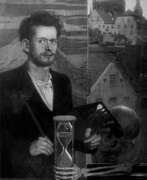

Oskar Bruno Zwintscher was a German painter. He is often associated with the Jugendstil movement. From 1887 to 1890 he studied at the Hochschule für Grafik und Buchkunst Leipzig and, from 1890 to 1892 was a student at the Dresden Academy of Fine Arts. After his studies, he became a free-lance painter in Meißen, where he received a stipendium, awarded to Saxon painters by the "Munkeltsche Legat". In 1898, he presented his first large collection of paintings to the public. That same year, he was a prizewinner at a contest held by the entrepreneur Ludwig Stollwerck to select artists for a new line of trading cards. His first series of cards, "Jahreszeiten" (The Seasons), was published later that year. This was followed in 1900 by "Das Gewitter" (The Tempest). From 1903, he served as a professor at the Dresden Academy. He was an unshakable opponent of impressionism. Despite this, and his involvement with advertising, much of his work is openly erotic or has an eerie quality. His style has been likened to a contemporary version of Holbein or Cranach, but also contains elements of Art Nouveau.
